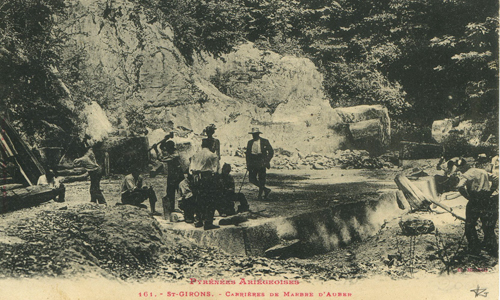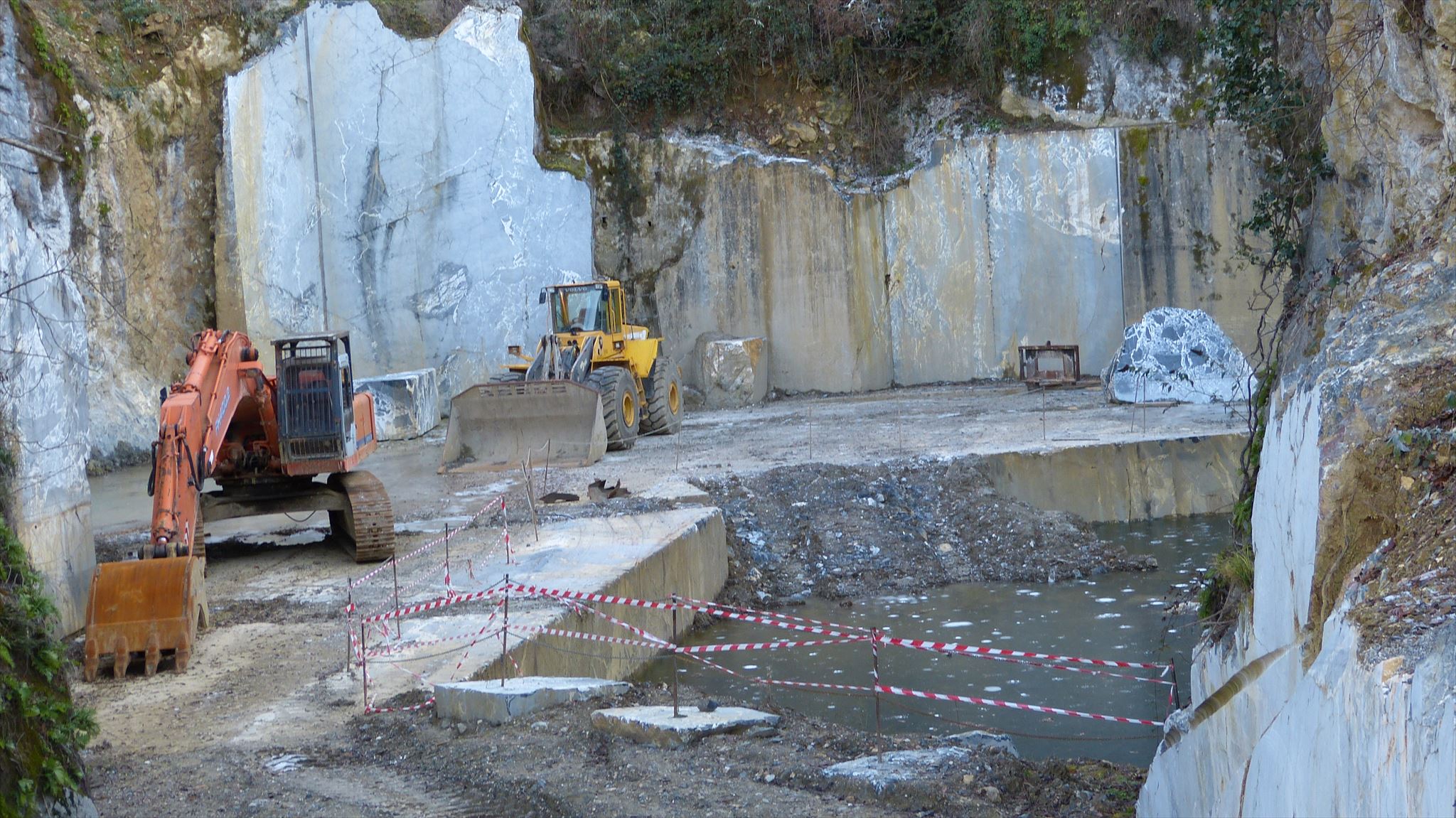Cette EarthCache vous permettra d'approfondir vos connaissances à propos d'un roche présente en Ariège et souvent oubliée :
Le marbre "Grand Antique"

Quelques définitions :
Les marbres (car il en existe différentes sortes) au sens strict sont des roches métamorphiques (roches argileuses ou marneuses qui ont subi une compression - un rapprochement de deux plaques, par exemple - et qui peuvent se déliter en feuillets ou en plaques) provenant de la recristallisation d’anciens calcaires, dans le contexte de la formation des chaines de montagne. Les marbres chimiquement purs sont blancs. Cependant ils présentent le plus souvent de grandes variations de couleurs et d’aspects. Les marbres présentent une grande diversité de coloris, bien que la couleur de base de la calcite soit le blanc. On y trouve fréquemment des veines appelées marbrures. Les veines et les coloris sont généralement dus à des inclusions d'oxydes métalliques.
 Carrière de marbre d'Aubert
Carrière de marbre d'Aubert
Une carrière est le lieu d'où sont extraits des matériaux de construction tels que la pierre, le sable ou différents minéraux non métalliques ou carbonifères. Vous l'avez sûrement deviné : dans le cas de la carrière d'Aubert, la roche extraite est le marbre.
Composition des marbres :
Les marbres blancs, gris, roses, sont constitués de cristaux de calcite (ou de dolomite) jointifs de plus ou moins grande taille (inférieure au mm jusqu’à supérieure au cm). Pour les distinguer les uns des autres il faut recourir à des analyses chimiques (éléments en trace, isotope du carbone et de l’oxygène).
Formation géologique du marbre :
La présence de roches métamorphiques (marbre et shiste) dans la chaîne des Pyrénées remonte à l'ère du Précambrien (entre la formation de la Terre et le début des temps fossilifères) : c’est à cette ère que les plus hauts sommets frontaliers entre la France et l’Espagne doivent leur composition en sédiments et roches métamorphiques. Ce qui explique le nombre de carrières de marbre présentes dans les Pyrénées, comme celle d'Aubert.
Il y a 100 millions d'années, au Crétacé moyen, l'Espagne quitte la proximité du Massif armoricain, mouvement qui va aboutir à la formation des Pyrénées, tout en coulissant le long de la faille nord pyrénéenne (zone d'accidents tectoniques).
Ceci a abouti à la création de la zone métamorphique nord pyrénéenne qui mêle calcaires métamorphiques (marbres) et roches volcaniques (syénites).
Un peu d'histoire :
Les premiers travaux dans la carrière d'Aubert sont datés de l’époque romaine. Les romains exportèrent ce matériau, qu’ils appelaient « marmor celticum », en grandes quantités à Rome et à Constantinople. Plus tard, durant l’époque byzantine, il fut très utilisé pour la décoration du plus grand chef-d’œuvre de l’architecture de l’époque: l’HAGIA SOPHIA d’Istanbul. Après cette période de grande activité, la carrière fut abandonnée et les blocs furent employés pour la décoration de la Basilique de Saint-Pierre, de Sainte-Marie Majeure, de la Basilique de Sainte-Cécile à Rome et de la Basilique de Saint-Marc à Venise.

La carrière fut rouverte au XIXe mais, après une grande exploitation du marbre d'Aubert, notamment dans les années 1920 où il avait été utilisé en grande quantité pour la façade de l'hôtel Roosevelt, à New York, la carrière de marbres dut être une nouvelle fois fermée dans les années 1950, certainement en 1952.
Mais un projet ayant pour but de poursuivre l'exploitation du marbre d'Aubert a été mené en 2012. Ce matériau unique permet de réaliser deux catégories de marbre : le grand antique d'Aubert, qui représente 40 % du marché, et le noir antique, qui représente 60 % du marché.

Peu à peu, le marbre de Moulis (d'Aubert) s'est fait un nom, jusqu'en 2015 où la marque marbre «grand antique d'Aubert» a officiellement été déposée.
Le "Grand Antique", un marbre prestigieux et un rayonnement international :
L'entreprise d'exploitation du marbre va jusqu'à faire rayonner l'Ariège à l'international avec des ventes à Londres, au Japon ou encore à Brooklyn, aux États-Unis.
Plus exceptionnel, le grand antique d'Aubert va être utilisé à New York dans la tour de verre appelée MoMA, construite par l'architecte français Jean Nouvel dans la 53e rue, à Manhattan. Cette tour comprendra des appartements de luxe et plusieurs étages qui seront consacrés à des galeries publiques complémentaires au MoMA, le musée d'art contemporain. Et c'est le français Thierry Despont, qui l'emploiera dans la décoration intérieure.
Caractéristiques du marbre "Grand Antique" :

Ce marbre prestigieux est noir et blanc, ses tonalités créent un contraste très net, qui n’est présent dans aucun autre marbre aux mêmes couleurs.
Extraction du marbre :
 Fil diamanté pour carrière
Fil diamanté pour carrière
Dans le cas du marbre d'Aubert, l'extrcation sera au maximum de 200 m3 par an, soit l'équivalent d'environ 600 tonnes. Cette limite permet de limiter l'impact de l'extraction sur la carrière. C'est-à-dire deux à trois campagnes d'extraction par an. Celles-ci se pratiquent au fil diamanté et à la haveuse, dans le marbre aucun explosif n'est utilisé.

Sources :
https://fr.wikipedia.org/wiki/Marbre (définition du marbre)
https://journals.openedition.org/crcv/13623 (composition des marbres)
http://www.escavamar.com/fr/notre-carriere.php (caractéristiques du marbre "Grand Antique")
http://lac.pyrenees.free.fr/pyrenees.htm (formation géologique du marbre dans les Pyrénées)
https://www.ladepeche.fr/article/2013/03/11/1579359-moulis-le-marbre-grand-antique-d-aubert-sort-de-l-oubli.html (extraction du marbre d'Aubert/réhabilitation de la carrière)
Pour valider cette EarthCache, il faudra répondre à ces quelques questions :
Dans le Descriptif :
- De quel type de roche fait partie le marbre ?
- Comment s'appellent les veines que l'ont retrouvent fréquemment dans le marbre ?
- De quel élément est composé le marbre ?
- Quelle est l'origine de la présence de carrières de marbre dans les Pyrénées ?
- En quelle année a été réouverte cette carrière ?
- Citez un monument ou bâtiment composé du marbre d'Aubert à l'époque byzantine, dans les années 1920 et récemment.
- De quand datent les premiers travaux de la carrière d'Aubert ?
- Pourquoi y a-t-il une limite de la quantité de marbre extraite ?
- Quels sont les méthodes d'extraction du marbre d'Aubert ?

Rendez-vous aux coordonnées indiquées de la cache :
- Observez les blocs présents sur le côté, quelle est leur couleur ?
- Cela vous paraît-il conforme au descriptif du marbre d'Aubert ?
- D'après vous, pourquoi les blocs sont-ils comme cela ?
- FACULTATIF - Une photo de vous, de votre GPS ou de tout autre objet vous représentant en tant que géocacheur n'est pas obligatoire, mais serait appréciée !
Loguez cette cache "Found it" et envoyez-moi vos propositions de réponses soit via mon profil, soit via la messagerie geocaching.com (Message Center), et je vous contacterai en cas de problème. N'attendez-pas une confirmation de vos réponses pour pouvoir loguer.
Bonnes recherches !

Some definitions:
Marbles (because there are different kinds) in the strict sense are metamorphic rocks (argillaceous or marly rocks that have undergone compression - a reconciliation of two plates, for example - and which can disintegrate into sheets or slabs) from the recrystallization of ancient limestones, in the context of the formation of mountain ranges. Chemically pure marbles are white. However, they most often present large variations of colors and aspects. Marbles have a wide variety of colors, although the basic color of calcite is white. There are frequently veins called marbling. Veins and colors are usually due to inclusions of metal oxides.
 Marble quarry of Aubert
Marble quarry of Aubert
A quarry is the place from which building materials such as stone, sand or various non-metallic or carboniferous minerals are extracted. In the case of Aubert's quarry, the extracted rock is marble.
Composition of the marbles:
The white, gray or pink marbles consist of crystals of calcite (or dolomite) contiguous of greater or lesser size (less than the mm up to the cm). To distinguish them from each other one must resort to chemical analyzes (trace elements, isotope of carbon and oxygen).
Geological formation of marble:
The presence of metamorphic rocks (marble and shistes) in the Pyrenees chain dates back to the Precambrian era (between the formation of the Earth and the beginning of fossil times) : it is at this time that the highest border summits between France and Spain owe their composition to sediments and metamorphic rocks. This explains the number of marble quarries present in the Pyrenees, like that of Aubert.
100 million years ago, in the Middle Cretaceous, Spain leaves the proximity of the Armorican Massif, movement that will lead to the formation of the Pyrenees, while sliding along the north Pyrenean fault (zone of tectonic accidents).
This culminated in the creation of the northern Pyrenean metamorphic zone which mixes metamorphic limestones (marbles) and volcanic rocks (syenites).
A little bit of history :
The first works in the quarry are dated from Roman times. The Romans exported this material, which they called "marmor celticum", in large quantities to Rome and Constantinople. Later, during the Byzantine period, it was widely used for the decoration of the greatest masterpiece of architecture of the time: the HAGIA SOPHIA of Istanbul. After this period of great activity, the quarry was abandoned and the blocks were used to decorate the Basilica of St. Peter, St. Mary Major, the Basilica of St. Cecilia in Rome and the Basilica of St. Mark in Venise

The quarry was reopened in the 19th century, but after a large exploitation of Aubert's marble, especially in the 1920s when it had been used in large quantities for the facade of the Roosevelt Hotel in New York, the marble quarry had to be closed in the 1950s, certainly in 1952.
But a project aiming to continue the exploitation of Aubert's marble was carried out in 2012. This unique material makes it possible to realize two categories of marble: the great antique of Aubert, which represents 40% of the market, and the black one antique, which represents 60% of the sales.

Gradually, the marble of Moulis made a name, until 2015 when the marble mark "grand antique of Aubert" was officially deposited.
The "Grand Antique", a prestigious marble and an international influence:
The marble exploitation company goes so far as to make Ariège shine internationally with sales in London, Japan or Brooklyn, in the United States.
More exceptional, the great antique Aubert will be used in New York in the glass tower called MoMA, built by the French architect Jean Nouvel in 53rd Street in Manhattan. This tower will include luxury, multi-story apartments that will be dedicated to additional public galleries at MoMA, the Museum of Contemporary Art. And it's the French Thierry Despont, the architect of billionaires, who will use it in interior decoration.
Characteristics of "Grand Antique" marble:

This prestigious marble is black and white, its tones create a sharp contrast, which is present in no other marble in the same colors.
Extraction of the marble:
 Diamond wire
Diamond wire
In the case of Aubert marble, the extraction will be a maximum of 200 m3 per year, the equivalent of about 600 tonnes. This limit limits the impact of extraction on the quarry. That is to say two to three extraction campaigns per year. These are practiced with diamond wire and the shearer, in the marble no explosive is used.

Sources:
https://en.wikipedia.org/wiki/Marble (definition of marble)
https://journals.openedition.org/crcv/13623 (composition of marbles)
http://www.escavamar.com/fr/notre-carriere.php (characteristics of the marble "Grand Antique")
http://lac.pyrenees.free.fr/pyrenees.htm (geological formation of marble in the Pyrenees)
https://www.ladepeche.fr/article/2013/03/11/1579359-moulis-le-marbre-grand-antique-d-aubert-sort-de-l-oubli.html (extraction of marble Aubert / rehabilitation of the quarry)
To validate this EarthCache, it will be necessary to answer these questions:
In the Description:
- What kind of rock is marble ?
- What are the veins that are frequently found in marble ?
- What element is marble made of ?
- What is the origin of the presence of marble quarries in the Pyrenees ?
- In which year was this career reopened ?
- Name a monument or building made of Aubert marble in Byzantine times, in the 1920s and recently.
- When did the first works of Aubert's career date ?
- Why is there a limit on the amount of marble extracted ?
- What are the methods of extraction of Aubert marble ?

Now, go to the indicated coordinates :
- Observe the blocks on the side, what is their color ?
- Does this seem consistent with the description of Aubert's marble ?
- And, in your opinion, why ?
- OPTIONAL - A photo of you, your GPS or any other object representing you as a geocacher is not required, but would be appreciated !
Log this cache "Found it" and send me your suggestions for answers either through my profile or via the messaging geocaching.com (Message Center), and I will contact you in case of problems. Do not wait for a confirmation of your answers to be able to log.
Good research!